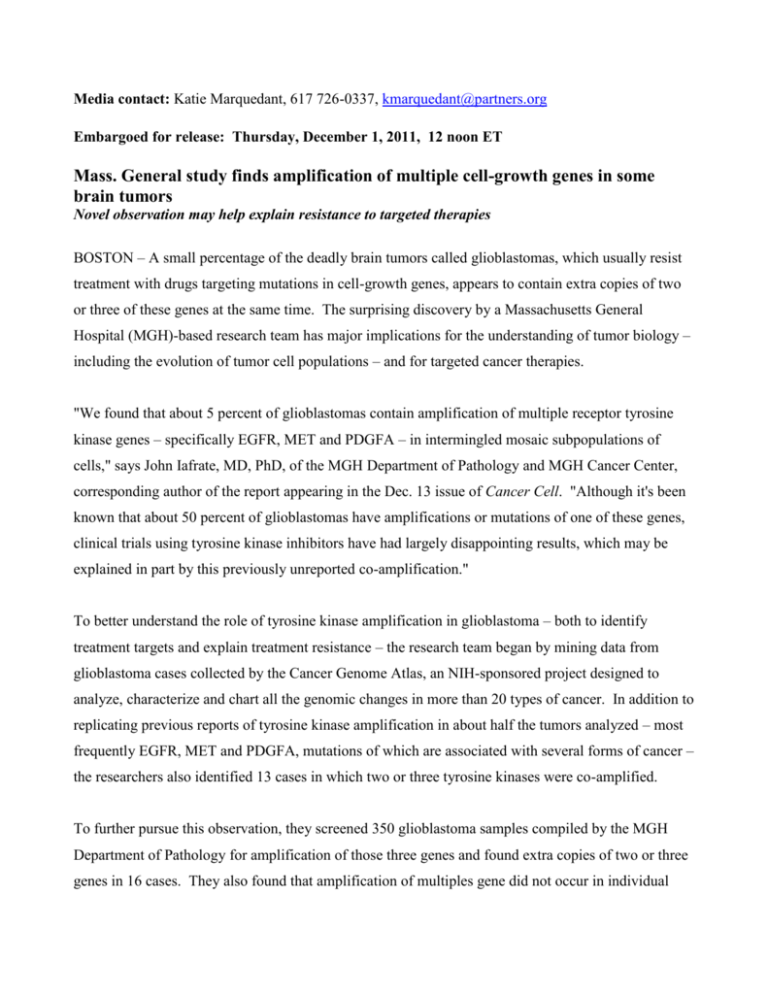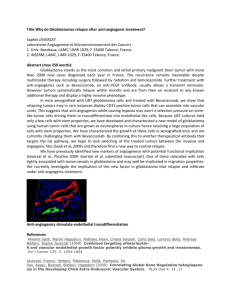Media contact: Katie Marquedant, 617 726
advertisement

Media contact: Katie Marquedant, 617 726-0337, kmarquedant@partners.org Embargoed for release: Thursday, December 1, 2011, 12 noon ET Mass. General study finds amplification of multiple cell-growth genes in some brain tumors Novel observation may help explain resistance to targeted therapies BOSTON – A small percentage of the deadly brain tumors called glioblastomas, which usually resist treatment with drugs targeting mutations in cell-growth genes, appears to contain extra copies of two or three of these genes at the same time. The surprising discovery by a Massachusetts General Hospital (MGH)-based research team has major implications for the understanding of tumor biology – including the evolution of tumor cell populations – and for targeted cancer therapies. "We found that about 5 percent of glioblastomas contain amplification of multiple receptor tyrosine kinase genes – specifically EGFR, MET and PDGFA – in intermingled mosaic subpopulations of cells," says John Iafrate, MD, PhD, of the MGH Department of Pathology and MGH Cancer Center, corresponding author of the report appearing in the Dec. 13 issue of Cancer Cell. "Although it's been known that about 50 percent of glioblastomas have amplifications or mutations of one of these genes, clinical trials using tyrosine kinase inhibitors have had largely disappointing results, which may be explained in part by this previously unreported co-amplification." To better understand the role of tyrosine kinase amplification in glioblastoma – both to identify treatment targets and explain treatment resistance – the research team began by mining data from glioblastoma cases collected by the Cancer Genome Atlas, an NIH-sponsored project designed to analyze, characterize and chart all the genomic changes in more than 20 types of cancer. In addition to replicating previous reports of tyrosine kinase amplification in about half the tumors analyzed – most frequently EGFR, MET and PDGFA, mutations of which are associated with several forms of cancer – the researchers also identified 13 cases in which two or three tyrosine kinases were co-amplified. To further pursue this observation, they screened 350 glioblastoma samples compiled by the MGH Department of Pathology for amplification of those three genes and found extra copies of two or three genes in 16 cases. They also found that amplification of multiples gene did not occur in individual cells but that subpopulations of cells – some with extra copies of one gene, some with another – were intermingled throughout the tumors forming a mosaic pattern. Additional testing revealed that each subpopulation was actively proliferating and contributing to tumor growth. Detailed genetic analysis found that different subpopulations within a particular tumor shared other gene mutations, indicating they had originated from the same precursor cells. Mapping the location of different subpopulations in the brain of a glioblastoma patient suggested that each subpopulation may serve a different function in the growth and spread of the tumor. "This new type of genetic variation within a tumor has not been described before – probably because of the technical limitations of whole genome analysis," says Iafrate, an associate professor of Pathology at Harvard Medical School. "We now need to perform functional experiments to explore interactions between subpopulations within a tumor and determine to what extent this may occur in other types of tumors. We are also beginning laboratory experiments to investigate combining multiple tyrosine kinase inhibitors for glioblastoma treatment." Matija Snuderl, MD, and Ladan Fazlollai, MD, of the MGH Department of Pathology are co-lead authors of the Cancer Cell article. Additional co-authors are Long Le, MD, PhD, Mai Nitta, Boryana Zhelyazkova, Christian Davidson, MD, Sara Akhavanfard, MD, and David Louis, MD, MGH Pathology; Daniel Cahill MD, PhD, and Kenneth Aldape, MD; M.D. Anderson Cancer Center, and Rebecca Betensky, Harvard School of Public Health. Celebrating the 200th anniversary of its founding in 1811, Massachusetts General Hospital is the original and largest teaching hospital of Harvard Medical School. The MGH conducts the largest hospital-based research program in the United States, with an annual research budget of nearly $700 million and major research centers in AIDS, cardiovascular research, cancer, computational and integrative biology, cutaneous biology, human genetics, medical imaging, neurodegenerative disorders, reproductive biology, regenerative medicine, reproductive biology, systems biology, transplantation biology and photomedicine. ###







